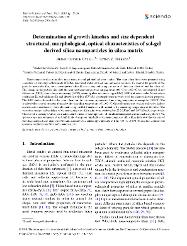| dc.contributor.author | Uysal, Bengü Özuğur | |
| dc.contributor.author | Tepehan, Fatma Zehra | |
| dc.date.accessioned | 2019-06-27T08:01:45Z | |
| dc.date.available | 2019-06-27T08:01:45Z | |
| dc.date.issued | 2019 | |
| dc.identifier.issn | 2083-134X | en_US |
| dc.identifier.uri | https://hdl.handle.net/20.500.12469/459 | |
| dc.identifier.uri | https://doi.org/10.2478/msp-2019-0010 | |
| dc.description.abstract | Nanocomposite silica thin films made using the sol-gel method were studied. The nano-silica films were prepared using a mixture of tetraethyl orthosilicate (TEOS) deionized water ethanol and ammonia solution. To control the growth of the particles inside the film the nanocomposite silica film was prepared using a mixture of the nano-silica sol and the silica sol. The change in the particle size with the heat treatment temperature ranging from 450 degrees C to 1100 degrees C was investigated. X-ray diffraction (XRD) atomic force microscopy (AFM) scanning electron microscopy (SEM) NKD (refractive index-N extinction coefficient-K and thickness-D) and ultraviolet-visible (UV-Vis) spectrophotometry were used for characterization purposes. The XRD studies showed that the nano-silica thin films were amorphous at all annealing temperatures except for 1100 degrees C. The alpha-cristobalite crystal structure formed at the annealing temperature of 1100 degrees C. Optical parameters such as refractive indices and extinction coefficients were obtained using the NKD analyzer with respect to the annealing temperature of the films. The activation energy and enthalpy of the nanocomposite silica film were evaluated as 22.3 kJ/mol and 14.7 kJ/mol respectively. The cut-off wavelength values were calculated by means of extrapolation of the absorbance spectra estimated using the UV-Vis spectroscopy measurements. A red shift in the absorption threshold of the nanocomposite silica films indicated that the size of the silica nanoparticles increased with an increase of the annealing temperatures from 450 degrees C to 900 degrees C and this confirms the quantum confinement effect in the nanoparticles. | en_US] |
| dc.language.iso | eng | en_US |
| dc.publisher | De Gruyter Poland Sp Zoo | en_US |
| dc.rights | info:eu-repo/semantics/openAccess | en_US |
| dc.subject | Particle size | en_US |
| dc.subject | Silicon dioxide | en_US |
| dc.subject | Sol-gel method | en_US |
| dc.subject | Nanoparticled composite thin films | en_US |
| dc.title | Determination of growth kinetics and size dependent structural morphological optical characteristics of sol-gel derived silica nanoparticles in silica matrix | en_US |
| dc.type | article | en_US |
| dc.identifier.startpage | 16 | en_US |
| dc.identifier.endpage | 24 | |
| dc.relation.journal | Materials Science | en_US |
| dc.identifier.issue | 1 | |
| dc.identifier.volume | 37 | en_US |
| dc.department | Fakülteler, Mühendislik ve Doğa Bilimleri Fakültesi, Biyoinformatik ve Genetik Bölümü | en_US |
| dc.identifier.wos | WOS:000460514400003 | en_US |
| dc.identifier.doi | 10.2478/msp-2019-0010 | en_US |
| dc.identifier.scopus | 2-s2.0-85062869787 | en_US |
| dc.institutionauthor | Uysal, Bengü Özuğur | en_US |
| dc.relation.publicationcategory | Makale - Uluslararası Hakemli Dergi - Kurum Öğretim Elemanı | en_US |
















